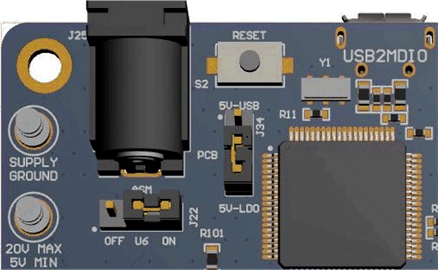SNLU237A September 2018 – January 2024 DP83869HM
- 1
- DP83869EVM
- Trademarks
- 1Definitions
- 2Introduction
- 3Board Setup Details
-
4Configuration Options
- 4.1
Bootstrap Options
- 4.1.1 Straps for PHY Address
- 4.1.2 Strap for DP83869 Functional Mode Selection
- 4.1.3 Straps for RGMII/SGMII to Copper
- 4.1.4 Straps for RGMII to 1000Base-X
- 4.1.5 Straps for RGMII to 100Base-FX
- 4.1.6 Straps for Bridge Mode (SGMII-RGMII)
- 4.1.7 Straps for 100 M Media Converter
- 4.1.8 Straps for 1000 M Media Convertor
- 4.2 SGMII/Fiber Interface
- 4.3 RGMII
- 4.4 Clock Output
- 4.5 Clock Input
- 4.6 Switch Configuration Options
- 4.1
Bootstrap Options
- 5Schematics
- 6Revision History
2.2.1 Onboard Power Supply Operation
The EVM can be supplied power through multiple options. Single-supply operation uses onboard LDOs to generate the voltages required for operating various sections of the EVM (PHY, MSP430, FO transceiver, and so forth).
 Figure 2-3 Onboard Power Supply Connection
Figure 2-3 Onboard Power Supply ConnectionThe EVM can be supplied power by either a J25 barrel jack connector, power-supply turrets, or a USB
- For Barrel Jack and Turret, connect the jumper in the ON position to J22 and the jumper on 5V-LDO to J34.
- For USB power, connect the Jumper on 5V-USB position to J34. J22 is don’t care.